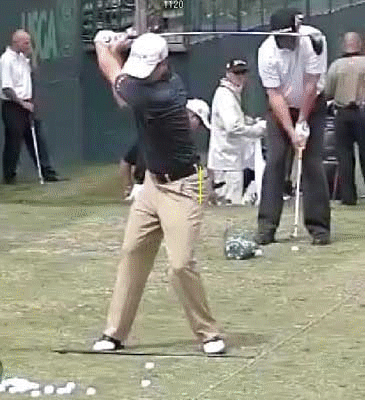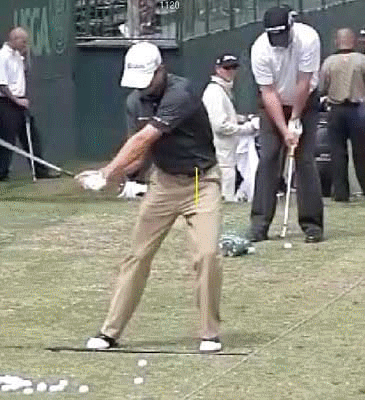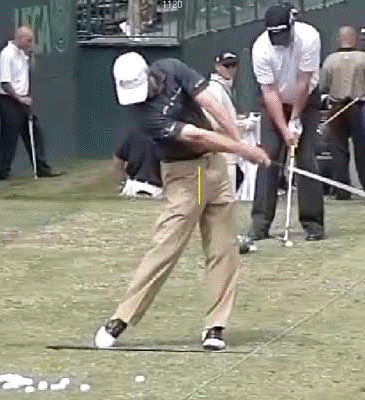Tour Accuracy Optimized MFT Swing
- by Kelvin Miyahira
We interrupt this series on power in the golf swing for an important article. Instead of only focusing on the power in golf, the accuracy needed to play a narrow course like Waialae Country Club, site of the Sony Open is just as important as raw distance. While Bubba Watson, JB Holmes, Robert Garrigus and the other long hitting players missed the cut that week, the accurate players like Zach Johnson, Brian Gay, David Toms, Tadd Fujikawa and the like dominated the leaderboard.
What’s important about all of this? A variation of the MFT swing has its place in all of the accurate swings as well. Players lacking the genetics and swing of Tiger and JB to pound the ball 320+ yards on the fly can still win tournaments and beat the best in the world if they maximize accuracy while giving up some distance to the longest hitters. But having said this, one must also keep in mind that these guys are still way longer than your average Joe and it might help everyone to investigate how these guys do it so well.
So this month, let’s take a look at the 2009 Sony Open Champion and former Masters Champion Zach Johnson’s great swing to see what we can learn about the Tour Accuracy-Optimized MFT swing or the TAO MFT swing for short. For the majority of players on the PGA Tour, the TAO MFT swing is THE WAY. Even Tiger uses this swing for his short irons and wedges while only using his full powered MFT swing for his drives and longer clubs.
This may be the way for you to increase your accuracy and distance (if you’re a WUT swinger or flipper). And I’m sure everyone would be in heaven if they could have Zach Johnson’s blend of accuracy and distance. So if you’re interested in having both, read on.
Let’s begin by delineating the differences between the three swings (TAO MFT, full powered MFT and the WUT swing).
TAO MFT vs. full powered MFT Transition

After studying a lot of swings using 300 fps Casio EX-F1 camera, we have found that the majority of the tour players have more toned down transitions. Instead of using the full powered MFT transition that is longer, more dynamic and has more energy, the accurate players have much shorter transitions, are far less dynamic and therefore builds up less energy. ZJ’s swing has about half the “fall in” frames as Tiger and a quieter, closed hip bump. While his transition is subtler, it is still very apparent. All the moves of a great swing are there.
Cruisin’ Before the Bruisin’
TAO MFT swing

After the short transition in the TAO MFT swing, a distinctive cruise mode follows. Instead, of firing immediately with the lower body, it starts with the arms and shoulders releasing some of the tension built up in torso during the transition. This is because the legs are in a holding pattern while the torso slowly rotates.
In one sense it would appear that the body is moving as “one.” Just as the outside of a bicycle wheel rotates faster than the center, the club and arms rotate around faster in order to appear to rotate together with the torso. This allows for time to get into the slot and also keep the arms from getting stuck behind their body.
Meanwhile, the body is moving slowly to get into position for a massive 2nd fire. So don’t be so impatient in this phase. Feel the closed hip bump or slide. Your abs and right obliques should be contracted to “hold” your position. Your weight should feel like it transfers down into your left foot (though not as aggressively as JS) and you should feel your arms dominating this part of the swing. Notice the closed hip position of ZJ here.
Full-powered MFT Swing
Contrast that to the full powered MFT swing, where the acceleration phase immediately follows the transition phase. Tiger or JS would have the lower body firing to power the swing once the lower body got into position after transition. This gives them more time and real estate in which to generate more speed and power.
Compared to WUT swing
The WUT swing uses more energy from the shoulders during this phase since the hips will transfer its momentum and speed to the shoulders. For many golfers, this might explain why many of you are over the top or have steep downswings. If one’s transition isn’t done properly, the shoulders will take over leading to the out and over move of the right shoulder.
MFT Acceleration Phase

The TAO MFT swing has a shorter acceleration phase since some of the time and distance to the ball has been taken up by the cruising phase. Thus instead of starting the acceleration phase when the left arm is at the 9 o’clock or horizontal position, it starts just a bit later or when the arms reach about 8 o’clock or 7:30.
As you would imagine, this sets the shoulders off into a firing immediately after. In this regard, the MFT swings are all alike.
Accuracy and power are enhanced when the body moves together with the hands through the hitting or impact zone. (For those of you who want to get rid of the flip wrist release -- this is your answer.)
WUT Arm Acceleration phase
WUT swingers would typically be hitting with their arms while their hips and shoulders would be slowing down. The whip effect would be used to strike the ball. Sounds good? Not to me.
What does the 2nd Fire Do?
One of the immutable laws I’ve found in golf swings is that when large muscles slow down or stall, smaller ones pick up the slack and do the work. But what if you’re halfway down on the downswing and your hips and shoulders slow down? What’s going to happen to your swing? The result is that your arms will take over early in the downswing resulting in casting or early releasing.
When your body slows down a little later in the downswing (just before impact) this increases the chances of a flip release. So if you’re struggling with that problem, this might be part of the cure.
Other Positive Benefits
Very athletic people have a big problem. If you are one of those and have a 10 handicap and below, chances are you have a swing like Tiger’s college swing that he first brought on Tour. He called it the “ole swing.” His incredible athleticism and dynamic lower body would tend to fire out too fast during transition and early downswing. This would get the club stuck behind him. What followed was the inevitable flip to get the clubface squared and if not, huge blocks to the right and the occasional hooks. It is the single most feared problem of the low handicap golfer.
So what’s the solution? If you don’t need absolute power and just want to hit it straight, the TAO MFT swing might help you. It will allow you to get the club back in front before you unleash your lower body power. This is how the majority of the Tour guys do it. Why not you?
Hitting Wedges
And when it comes to hitting your wedge shots close, there isn’t a better way. The control is all within your grasp. Hitting half and three-quarter wedges is a breeze if you start your downswing with a short transition, then your arms and then feel your body fire before impact. It’s as easy as 1, 2, 3.
The Future
The WUT swing is not very prevalent on the Tour anymore. There are many more players performing the TAO MFT swing. Whether it is Tiger using a full powered MFT swing or the majority of the Tour players using the TAO MFT swing, they all fire their hips a 2nd time. The difference is in the intensity of the 1st fire of the hips during transition.
As for the amateurs – for those of you who do not want to be long and wild or for those who are struggling to get any swing going, the TAO MFT swing might be the answer for you. It is far easier to perform, learn and reproduce consistently. As an added plus, this might give you a greater insight to the swings you watch on Sunday afternoons on TV.